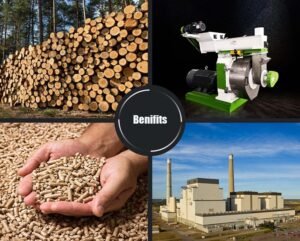
Grass pellet machines are in high demand globally due to their role in sustainable biomass fuel production and animal feed. However, the cost of these machines can differ significantly depending on the region. This article delves into the factors that cause these price discrepancies and provides a snapshot of price ranges across various parts of the world.
Factors Affecting Regional Price Differences
Several key elements contribute to the varying prices of grass pellet machines around the globe:
- Manufacturing Costs
- Production expenses, including labor and materials, differ widely between countries. For instance, production costs in China are typically lower than in Western nations, leading to cheaper machines.
- Import Duties and Taxes
- Import tariffs and taxes imposed by different countries can significantly impact the final cost of grass pellet machines.
- Transportation Costs
- The expense of shipping large machinery can be substantial and varies based on the distance between the manufacturer and the buyer, influencing prices in regions far from manufacturing centers.
- Market Demand
- High demand for grass pellet machines in certain areas can drive competitive pricing due to increased supplier competition.
- Technological Advancements
- Access to advanced technology in some regions can affect the price of high-end grass pellet machines.
- Local Regulations
- Environmental and safety regulations differ by region and may require additional features or certifications, impacting the machine’s price.
Price Ranges by Region
- China
- China is a leading manufacturer of grass pellet machines, offering some of the most competitive prices globally.
- Small-scale machines (50-500 kg/hour): $1,000 – $10,000
- Medium-scale machines (500-1000 kg/hour): $10,000 – $50,000
- Large-scale industrial machines (1-5 tons/hour): $50,000 – $200,000+
- China is a leading manufacturer of grass pellet machines, offering some of the most competitive prices globally.
- North America (USA and Canada)
- Higher labor costs and stricter regulations contribute to higher prices in North America.
- Small-scale machines: $5,000 – $20,000
- Medium-scale machines: $20,000 – $100,000
- Large-scale industrial machines: $100,000 – $500,000+
- Higher labor costs and stricter regulations contribute to higher prices in North America.
- Europe
- European prices are similar to North American prices, with variations between countries.
- Small-scale machines: €4,000 – €18,000
- Medium-scale machines: €18,000 – €90,000
- Large-scale industrial machines: €90,000 – €450,000+
- European prices are similar to North American prices, with variations between countries.
- Southeast Asia (excluding China)
- Prices in countries like Vietnam and Thailand are lower than in the West but higher than in China.
- Small-scale machines: $2,000 – $15,000
- Medium-scale machines: $15,000 – $70,000
- Large-scale industrial machines: $70,000 – $300,000+
- Prices in countries like Vietnam and Thailand are lower than in the West but higher than in China.
- Africa
- Prices vary widely depending on import costs and local manufacturing capabilities.
- Small-scale machines: $3,000 – $18,000
- Medium-scale machines: $18,000 – $80,000
- Large-scale industrial machines: $80,000 – $350,000+
- Prices vary widely depending on import costs and local manufacturing capabilities.
- South America
- Prices are influenced by import costs and local economic conditions.
- Small-scale machines: $3,000 – $18,000
- Medium-scale machines: $18,000 – $80,000
- Large-scale industrial machines: $80,000 – $350,000+
- Prices are influenced by import costs and local economic conditions.
Related post:https://www.richipelletmachine.com/hay-pellet-machine-for-sale/
Case Study: Comparing Prices for Medium-Scale Machines
Consider a medium-scale grass pellet machine with a capacity of 800 kg/hour:
- China: Around $30,000
- USA: Around $70,000
- Germany: Around €65,000 (approximately $75,000)
- Vietnam: Around $50,000
- Brazil: Around $60,000
This comparison highlights significant regional price differences for similar machines.
Implications of Regional Price Variations for Buyers
The substantial price variations across regions can have several impacts on buyers:
- Cross-Border Purchasing
- Some buyers might opt for machines from regions with lower prices, despite challenges related to shipping, customs, and after-sales support.
- Local Manufacturing Development
- High import prices might encourage local manufacturing, offering more affordable options.
- Quality Considerations
- Buyers need to weigh price against quality, as cheaper machines from some regions might not meet the same standards as more expensive ones.
- Total Cost of Ownership
- Beyond the initial purchase price, buyers should consider shipping, installation, maintenance, and operational costs, which vary by region.
Conclusion
The price of grass pellet machines varies widely across different regions, with differences of up to 200% or more for similar capacity machines. These variations are driven by factors such as manufacturing costs, import duties, transportation expenses, and local market conditions.
Chinese manufacturers often offer the most competitive prices globally, but buyers must consider more than just the initial cost. Quality, after-sales support, compliance with local regulations, and long-term operational costs are crucial factors.
As global demand for sustainable biomass solutions grows, price gaps may narrow. However, regional variations will likely persist due to differences in manufacturing capabilities, economic conditions, and regulatory environments.
Thorough research and consideration of all factors are essential for buyers choosing a grass pellet machine. Understanding regional price variations and their causes helps buyers make informed decisions that balance cost, quality, and long-term value.





